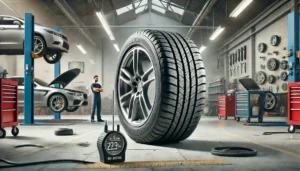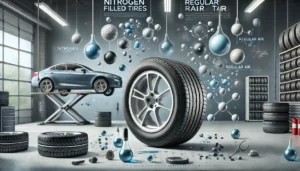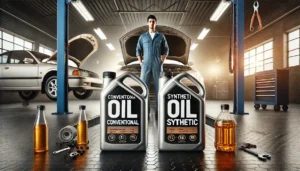There are multiple reasons why nitrogen vs air in tires debate making many car owners wonder if nitrogen-filled tires really make a difference. The hype is real and the core idea is that nitrogen, an inert gas with low moisture content, helps maintain tire pressure more consistently than regular air, reducing the air pressure loss common in air-filled tires.
This can lead to slightly better fuel efficiency, improved tire life, and less oxidation inside the wheel. In fact, commercial vehicles and high-performance cars often rely on nitrogen tires vs air because it supports longer-lasting pressure stability under varying temperatures.
In fact, government guidelines for aircraft maintenance, such as the FAA’s recommendations, highlight nitrogen’s stability under varying temperatures as a key reason it’s used in aviation and the same principle applies to car tires.
Why Do You Put Nitrogen in Tires as an Alternative to Air?
- Minimized gas permeability
- Reduced oxidative corrosion
- Enhanced stability under stress
Modern car tires and alloy wheels demand precise conditions to maintain proper tire pressure and overall integrity. Nitrogen, composed of diatomic molecules (N₂) larger and more stable than oxygen (O₂), infiltrates the tire rubber more slowly, minimizing air pressure loss and oxidation that can degrade internal wheel components.
Ideally, its lower moisture content also prevents internal corrosion. And when we specifically talk about oxidation and low moisture content, regular air contains about 21% oxygen, moisture, and trace gases. Nitrogen, on the other hand, at approximately 95%+ purity—contains virtually no water vapor and significantly less reactive content.
This dryness and inertness curtail oxidation that can corrode metal components and degrade rubber from the inside out.
So with this behind the scientific scenes, these factors matter even more today, as advanced suspension systems and high-speed tires require consistent pressure and uniform performance.
Research by NASA, highlights the importance of controlled gaseous environments, reinforcing the idea that nitrogen filled tires are a “premium air for tires” and a reliable alternative to air in tires for ensuring more uniform tire pressure stability, improved durability, and safer performance.
Nitrogen vs Air in tires: Can You Mix Nitrogen and Air in Tires?
Yes, you can, but it alters the chemical environment within the tire. Chemically, what happens when you mix nitrogen and oxygen? Oxygen molecules (O₂) are smaller and more reactive, making them more likely to permeate the rubber and accelerate internal corrosion.On the other hand, nitrogen is majorly opposite to regular; dry, bigger molecular, less reactive.
Nitrogen filled tires generally contain fewer reactive components and less moisture than standard “premium tire air” blends. Mixing air with nitrogen in tires introduces oxygen, humidity, and other trace gases back into the equation.
When these gases combine, the tire’s internal atmosphere shifts from a primarily inert environment toward one more prone to oxidation and pressure fluctuations. However, in real-world terms, adding regular air won’t harm the tire immediately, but it undermines nitrogen’s primary advantages like reduced permeability and less moisture-induced damage.
So, if you must top off with regular air, do it sparingly. Try to strive to maintain a high nitrogen concentration for the best balance of stability, durability, and improved tire performance over time.
Nitrogen Air For Tires: Pros and Cons
If you are still curious about “is nitrogen better for tires?” We have drawn a comparison with regular air in a table form so you can understand both practicality and accessibility in better way.
| Factor | Nitrogen-Filled Tires | Regular Air (Typical Gas) |
|---|---|---|
| Pressure Stability | More stable tire pressure over time, reduced air pressure loss, especially under temperature swings. | Prone to gradual loss of proper tire pressure due to oxygen and moisture permeation. |
| Oxidation & Corrosion | Lower oxidation risk inside wheels; helps maintain metal integrity and rubber elasticity. | Higher oxygen content promotes internal corrosion and faster chemical wear. |
| Moisture Content | Significantly drier “premium tire air”, minimizing rust and reducing rubber degradation. | Contains moisture and water vapor, which can lead to fluctuations in tire pressures and structural weakening. |
| Fuel Efficiency & Tread Life | Consistent inflation supports optimal fuel efficiency and longer tread life, beneficial for commercial vehicles. | Slightly quicker pressure loss may reduce efficiency and tire longevity over time. |
| Cost & Accessibility | Often more expensive and less accessible; requires specialized service to maintain high purity. | Readily available, free or low-cost, and easy to top up with a portable air compressor. |
| Performance & Application | Ideal for high-performance cars and those aiming for longer-lasting pressure stability; aligns with exacting demands of certain driving conditions. | Sufficient for standard vehicle type and everyday driving; simpler and cost-effective for most general uses. |
Can You Put Nitrogen in Any Tire? Is it Better For You?
Yes, virtually any car tire, whether on a standard passenger car or a high-performance vehicle, can be inflated with nitrogen. Modern tires are engineered to accommodate various gases, and nitrogen’s inert nature makes it a safe alternative to air in tires.
As mentioned above, the nitrogen molecules are larger and less reactive than oxygen, so they reduce oxidation and slow down air pressure loss. This translates into more consistent pressure, which can improve handling, fuel efficiency, and overall tire longevity. Whether you’re using a portable air compressor designed for nitrogen or visiting a specialized service center, inflating with nitrogen is straightforward.
While the benefits are more pronounced in commercial vehicles or racing applications, everyday drivers also stand to gain from nitrogen’s stability and protective qualities.
Frequently Asked Questions:
What does nitrogen do for tires?
Nitrogen helps maintain stable, proper tire pressure by reducing air pressure loss, as its larger molecules and low moisture content limit internal oxidation. This results in longer tread life, improved handling, and potentially better fuel efficiency.
Is nitrogen in tires worth it?
For many drivers, yes, especially those seeking longer-lasting pressure stability and consistent performance. While the benefits may be modest for casual use, nitrogen-filled tires often show reduced oxidation, more even wear, and can retain proper inflation over time.
Is nitrogen air?
Nitrogen is the primary component of air (about 78%), but when used in tires, it’s more purified. Unlike regular air, which includes oxygen and moisture, high-purity nitrogen delivers a drier, more stable inflation medium.
Nitrogen in tires myth
It’s not a myth that nitrogen tires vs air offer benefits like steadier pressure and reduced corrosion. However, while advantages exist, they’re often subtle, meaning nitrogen isn’t a “magic solution” but rather an incremental improvement over standard inflation.
What happens when you mix nitrogen and oxygen?
Mixing nitrogen with oxygen essentially recreates a standard air mixture. This can dilute nitrogen’s benefits by introducing moisture and oxygen, resulting in slightly more pressure fluctuations and a higher chance of internal tire oxidation.
Is nitrogen better than air in tires?
Generally, yes. Nitrogen’s inertness and low moisture content help maintain consistent pressure, slow down oxidation, and potentially improve efficiency. While not always dramatic, these benefits often make it a practical choice for performance-focused drivers.
Can you put air in nitrogen tires?
Absolutely. Topping up nitrogen-filled tires with regular air won’t damage them, but it lowers the nitrogen concentration. Over time, this may reduce the advantages you’d gain from pure nitrogen, such as stable pressure and reduced internal corrosion.



